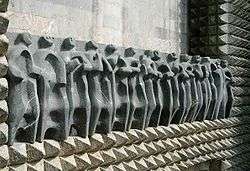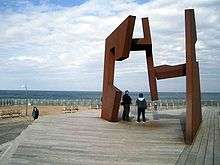Jorge Oteiza
Jorge Oteiza Enbil (October 21, 1908 – April 9, 2003), was a Basque Spanish sculptor, painter, designer and writer from the Basque Autonomous Community, renowned for being one of the main theorists on Basque modern art.[1][2] Oteiza was born in Orio (Gipuzkoa, Basque Autonomous Community, Spain).[2] He moved to South America in 1935, just before the Spanish Civil War, and stayed there for 14 years.[3] In 1963 he published Quosque tandem!, an essay about the aesthetics inherent to Basque soul, based on Basque prehistoric art and Basque people's anthropological roots.[4] Three years on, he contributed to found the artistic group Gaur.


He died in San Sebastián, Gipuzkoa, in 2003.[2] Following his will, a month after his death a museum dedicated to his career was opened in Alzuza, Navarre, in the place where he had lived since 1975. The Oteiza Museum is a monographic exhibition space housing the personal collection of Jorge Oteiza, which includes 1,690 sculptures, 2,000 experimental pieces from the artist’s Chalk Laboratory, and an extensive collection of drawings and collages.[5]
Main prizes and awards
Jorge Oteiza was granted several prizes and awards throughout his life:[6]

- 1953 — Only Spanish sculptor selected for the international competition for the Monument to the Unknown Political Prisoner. The project is exhibited in the Tate Gallery (London).
- 1954 — Spanish National Award of Architecture, for a project to do a chapel on the Road to Santiago. It was a joint project, together with architects F. J. Sáenz de Oiza and Luis Romaní, and it was not carried out.
- 1957 — Grand Prix for his sculpture at the IV São Paulo Art Biennial (Brazil).
- 1970 — First Prize in the competition for the urban planning of the Plaza de Colón in Madrid. It was a joint project, together with Angel Orbe, Mario Gaviria and Luis Arana, and it was not carried out.
- 1985 — Gold Medal for Fine Arts, awarded by the Spanish Ministry of Culture.
- 1986 — Selected for the exhibition Qu’est-ce que la sculpture moderne? 1900-1970, held in the Museum of Modern Art at the Georges Pompidou Center in Paris.
- 1988 — Prince of Asturias Prize for the Arts.
- 1991 — Gold Medal of Navarre, awarded by the Government of Navarre.
- 1995 — Manuel Lekuona prize by Eusko Ikaskuntza (Society of Basque Studies).
- 1996 — Pevsner Prize (Paris), in recognition of his life’s work.
- 1996 — Honorary member of the Vascon-Navarrese Architect’s Association.
- 1998 — Doctor honoris causa by the University of the Basque Country.
- 1998 — Madrid Fine Arts Circle Medal.
- 1998 — Gipuzkoa Gold medal.
References
- Grace Glueck (2005-07-08). "'Emptying' Sculpture to Make Room for Spiritual Energy". The New York Times. Retrieved 2010-03-02.
- Zallo, Ramón (2007). Basques, today. Alberdania. p. 144. ISBN 978-84-96643-59-8.
- de Oteiza, Jorge; Zulaika, Joseba (2003). Oteiza's selected writings. University of Nevada Press. p. 12. ISBN 978-1-877802-43-0.
- Oteiza; Zulaika (2003), p. 286
- "Oteiza Museum: General Information," from the Oteiza Museum's website. Retrieved 2010-11-08.
- "Biography," from the Oteiza Museum's website. Retrieved 2010-11-08.
External links
| Wikimedia Commons has media related to Jorge Oteiza. |
- Oteiza Museum in Alzuza, Navarre
- Biography
- Oteiza's Selected Writings at the Basque Database
- Two Basque Sculptors. Peter Selz on Oteiza and Chillida
- Arana Cobos, Juan (2008). Jorge Oteiza: Art as Sacrament, Avant-Garde and Magic. PhD dissertation, Center for Basque Studies. University of Nevada, Reno.
